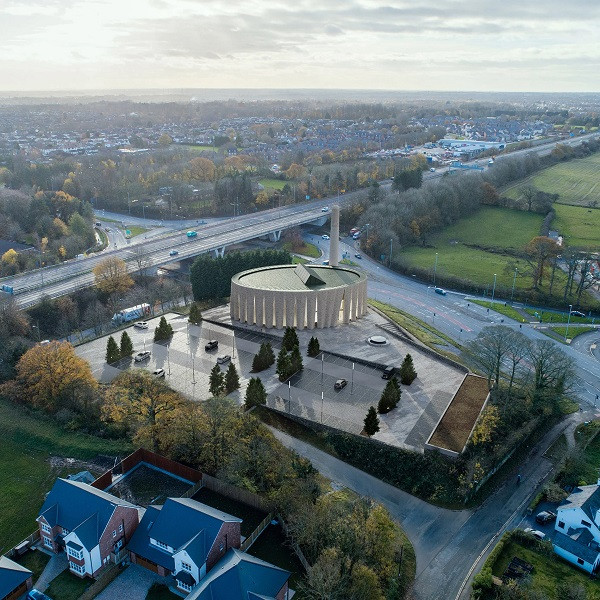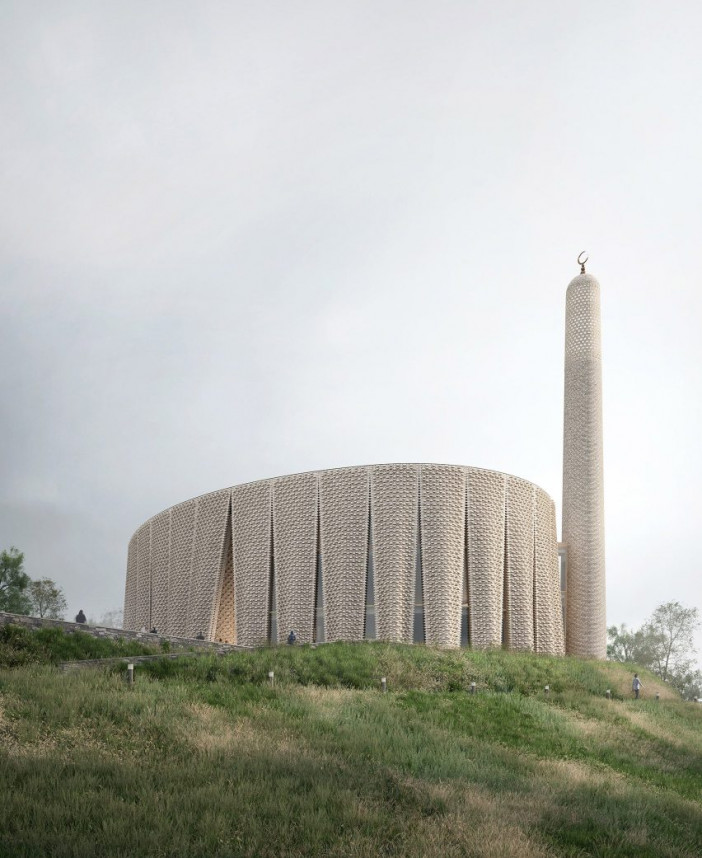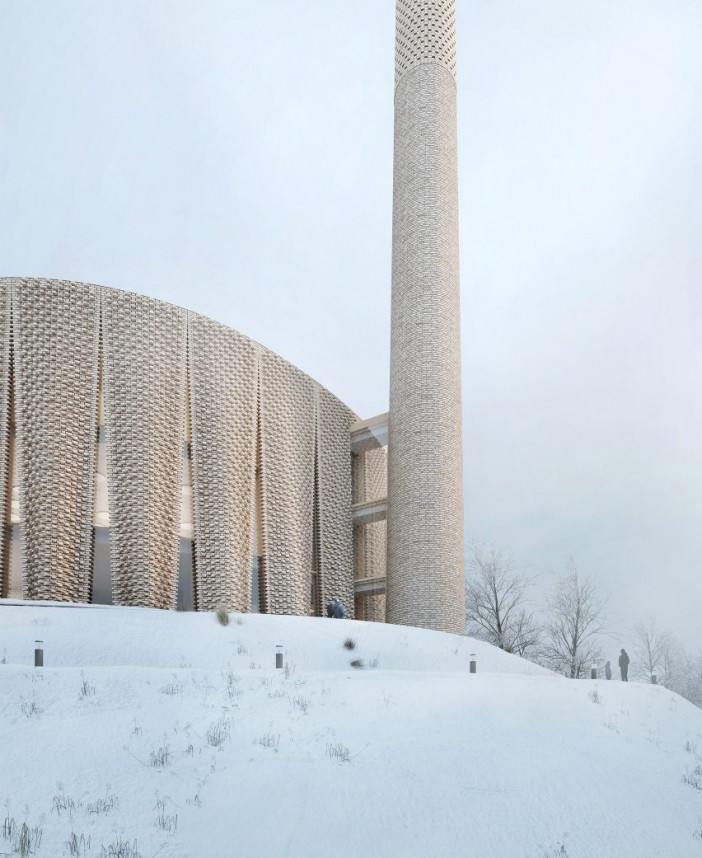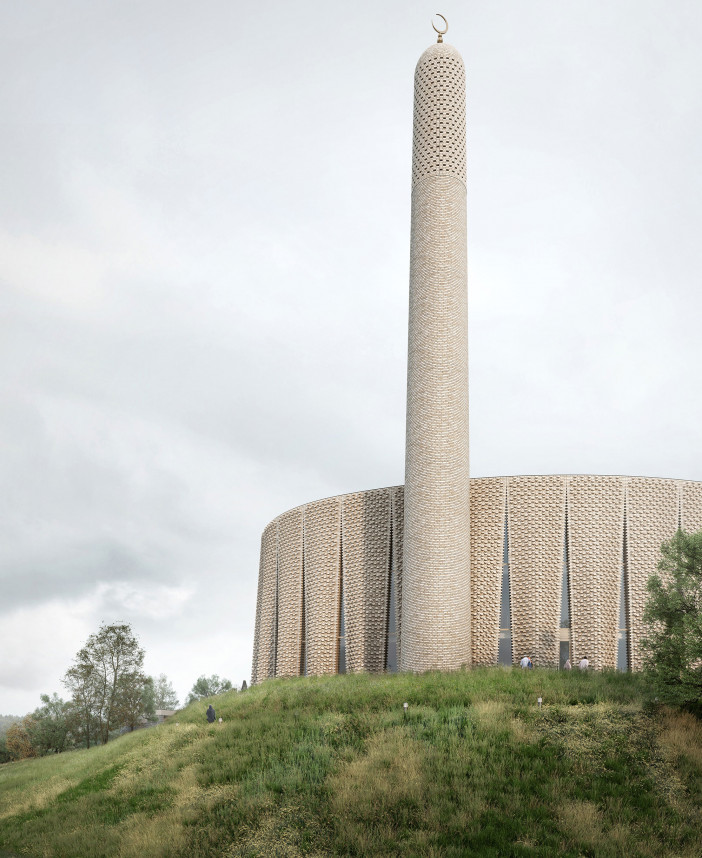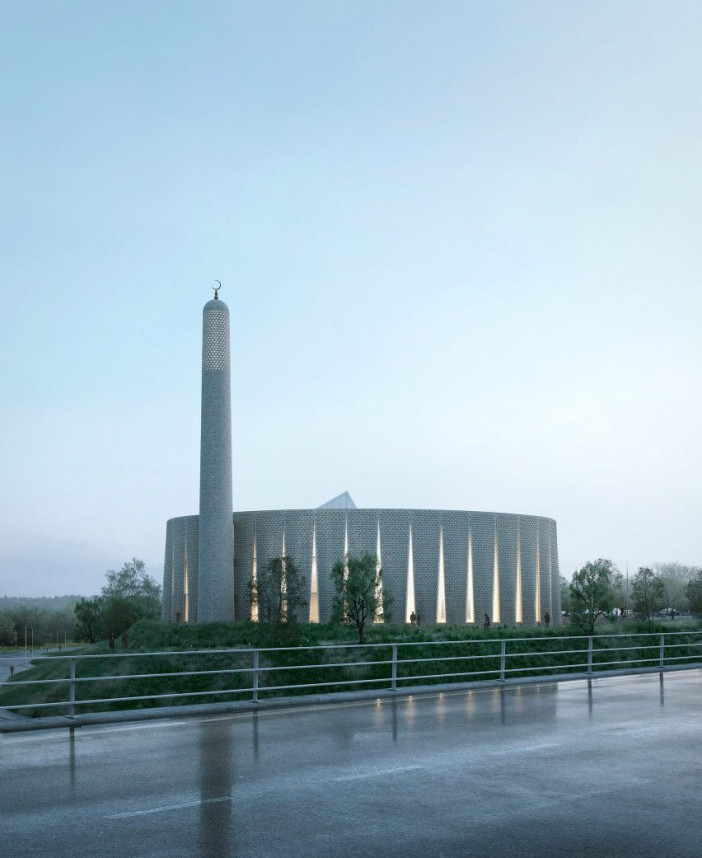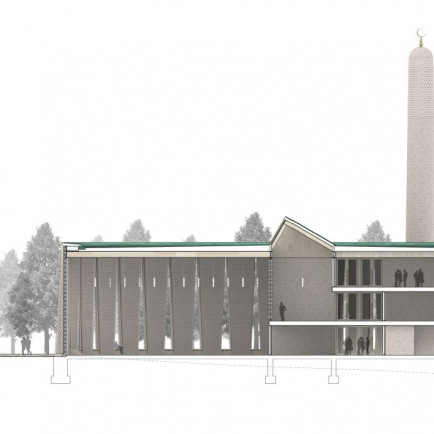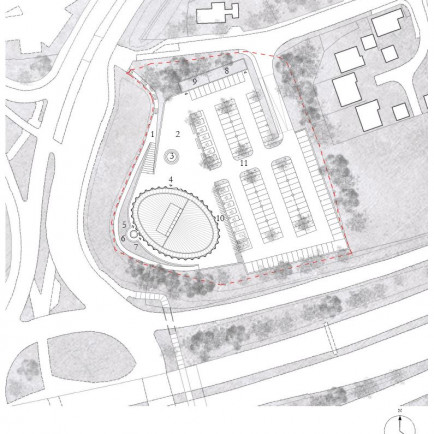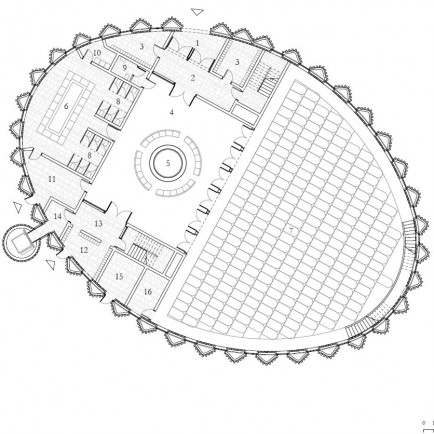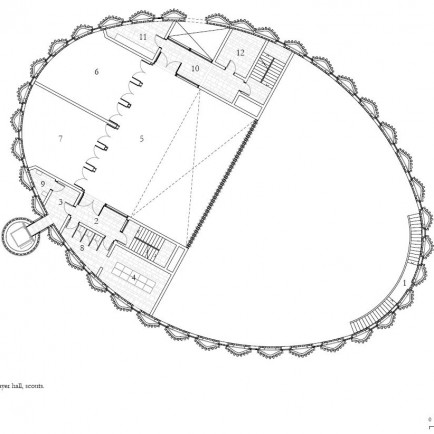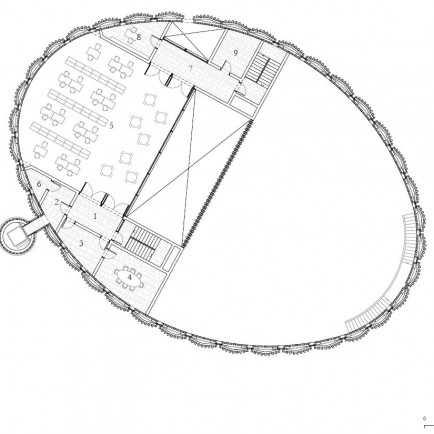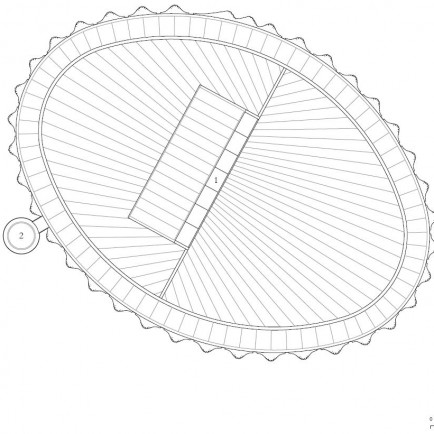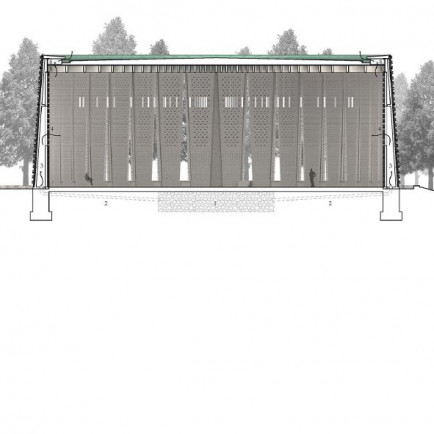Brick Veil Mosque
History
Our design retains the spatial richness and programmatic sequence typical of traditional mosques. A carefully choreographed sequence unfolds from the moment of arrival, taking on the character of a religious procession whilst framing the visitor’s experience of the building. A sinuous ramp provides a point of access for pedestrians into the site, navigating the topography of the hill and producing a slow transition from city to mosque - from urban to sacred. Sited at the cusp of the hill, a civic plaza (Sahan) frames the point of arrival and allows visitors to fully embrace the surrounding context from an elevated datum. Upon entering, the building unravels as a series of carefully articulated layers in plan, inviting male visitors into a grand lobby at ground level and leading female visitors to their own dedicated prayer facilities on level one. Flanking the main foyer, two dedicated stairs create separate routes for male and female visitors, inviting them to their respective ablution and prayer areas. Full accessibility has also been prioritised, and a dedicated passenger lift has been discreetly concealed within the structure of the minaret, adjacent to the entrance for female visitors.
The visitor’s experience culminates at the prayer hall. Devoid of superfluous ornament, the space allows the architecture to be fully manifested and experienced through a playful interplay of light and shadow, material and craft, surface and texture. The architecture is integral to the religious experience, and in a way heightens it by virtue of its scale, proportion and character. The interior of the prayer hall is permeated with natural light and views filtering through slit openings around the elliptical perimeter of the building, which will infuse the space with a different quality of light depending on the time of day and time of the year, creating a humbling and contemplative aura and atmosphere.
The building’s ancillary functions allow it to take on a wider civic agenda meant to not only preserve Islamic tradition, but also to create a heightened sense of community. Located on level one, a highly flexible multi-purpose hall will be built in symbiosis with the Islamic library, which will be located just above it at level two. A large skylight will drench both spaces in natural daylight, creating an experience that will stand in contrast to the quiet and reverential nature of the prayer hall below. The result is a rich and diverse architectural experience that not only pays homage to Preston’s diverse Muslim communities, but also proposes a new paradigm for the design of sacred Islamic architecture across the UK.
Urban and Architectural
The structural principles are simple and honest. Precast concrete wall panels around the perimeter of the building will provide both vertical support to the roof and floors, and lateral stiffness to resist the wind loads on the building. Internal floors will be in-situ concrete slabs with exposed soffits that will act as heat sinks and stores, to modulate any fluctuations of the internal temperature and environment. The internal dividing walls between the rooms will be used to support the floors in conjunction with a few slender exposed concrete columns. The oval roof has a simple, lightweight construction of deep glulam timber beams radiating out from the central spine wall to the perimeter, where they are supported on timber fins that sit on top of the perimeter wall. A steel ring beam runs around the top of the precast panels tying them all together and supporting the timber fins. The structure will be on show in the completed mosque, which will not only save on the need for costly and time consuming finishing trades, but more importantly will infuse this sacred building with an inherent honesty and clarity.
The precast façade panels will be fabricated off site and delivered and craned into position on a Just-in-Time basis. This has the benefits of higher quality control, improved safety on site, less materials on site and rapid construction. Panels are completely repetitive in form around the perimeter, meaning
that a single mould can be used to cast all the panels, maximising the cost benefits of precasting. The panels are shaped to be wider in cross section at their base and tapering towards the top, echoing the traditional masonry construction of castles, cathedrals and mills. This buttressing of the walls removes the need for internal floors to stabilise the walls, enabling a full height space to maximise the impact of the Male Prayer Hall. In order to achieve the wider base without excessive use of material,
the panels will have two reinforced concrete leaves - a straight inner leaf and a curved outer leaf. These leaves will be fabricated and delivered to site separately, and connected together on site. In between the leaves will be the insulation and membranes, but this interstitial space will also be used to route the air supply up and down the building.
Foundations could be low strength (and therefore low embodied carbon) mass concrete strips and pad footings if the superficial ground material is of reasonable strength. If not then small diameter reinforced concrete piles and shallow reinforced concrete ground beams will be used to support the walls and columns.
The slender Minaret will also be formed from curved precast concrete panels clad in brickwork that are fabricated off site. These panels will be either half or a quarter of a circle on plan, and in maximum
lengths for delivery and cranage. On site they will be craned into position and connected together
with grouted reinforcement across the joints. This construction will stabilise the tall and slender tower, while also enabling large openings in the walls near their base for the lift.
Description
The design has developed to maximise passive solutions to maintaining a comfortable internal environment
by using the building form and construction thereby minimising running cost and reducing CO2 emissions. Uniform glazing to the perimeter façade and north light will enable a even distribution of daylight and the ability to control the artificial lighting in combination with external day light to optimise the lighting provision. Our experience at the Mosque in Cambridge highlighted the need to detailed daylight modelling to achieve this as well as to study the daylight impact throughout the day and refine the design of the window openings.
With intermittent periods of increased occupancy we have developed a hybrid ventilation strategy utilising the floor void formed by the natural topology of the site. Air is drawn though a rock store to benefit from the thermal mass provided thereby tempering the air in summer and warming it in winter. The innovative structural solution to the façade will incorporate a means of distributing this tempered air to the space. During periods of high occupancy the air supply will be mechanically driven however for the majority of the time the process will be natural. To avoid bulky plant at roof level an attenuated natural exhaust path has been developed to avoid the need for a fan.
The future of gas for heating is potentially uncertain, given the Government carbon reduction objectives,
and we would look at how heat pumps could be integrated into the scheme in a financially viable way to enable flexibility in future. An external energy plant room has been included to house a potential electrical substation and heating source. A range of heat pump solutions will be investigated depending on budget and potential funding streams with the base case considering a horizontal-array ground source heat pump solution to meet the base load and a traditional gas boiler installation to deal with the peak. This is a more cost-efficient solution and provides a back up heat source to the building.
PV panels will be incorporated on the roof, for electrical power generation, where the profile provides optimal orientation for the solar collection.
References
https://www.dezeen.com/2021/09/29/brick-veil-mosque-luca-poian-forms-preston/
https://arqa.com/en/architecture/brick-veil-mosque.html
https://www.lucapoianforms.com/news/brick-veil-mosque-receives-outline-planning-permission/
https://www.lucapoianforms.com/projects/broughton-mosque/
https://littlerockhomenews.com/luca-poian-types-wraps-its-proposed-uk-mosque-in-a-textural-brick-veil
Details
Location
Preston, UK
Worshippers
250
Architect Name
Year of Build
under construction till 2025
Area
Site area: 8,850m2 Building area: 990m2 Total floor area: 1,685m2
Drawings
Map
History
Our design retains the spatial richness and programmatic sequence typical of traditional mosques. A carefully choreographed sequence unfolds from the moment of arrival, taking on the character of a religious procession whilst framing the visitor’s experience of the building. A sinuous ramp provides a point of access for pedestrians into the site, navigating the topography of the hill and producing a slow transition from city to mosque - from urban to sacred. Sited at the cusp of the hill, a civic plaza (Sahan) frames the point of arrival and allows visitors to fully embrace the surrounding context from an elevated datum. Upon entering, the building unravels as a series of carefully articulated layers in plan, inviting male visitors into a grand lobby at ground level and leading female visitors to their own dedicated prayer facilities on level one. Flanking the main foyer, two dedicated stairs create separate routes for male and female visitors, inviting them to their respective ablution and prayer areas. Full accessibility has also been prioritised, and a dedicated passenger lift has been discreetly concealed within the structure of the minaret, adjacent to the entrance for female visitors.
The visitor’s experience culminates at the prayer hall. Devoid of superfluous ornament, the space allows the architecture to be fully manifested and experienced through a playful interplay of light and shadow, material and craft, surface and texture. The architecture is integral to the religious experience, and in a way heightens it by virtue of its scale, proportion and character. The interior of the prayer hall is permeated with natural light and views filtering through slit openings around the elliptical perimeter of the building, which will infuse the space with a different quality of light depending on the time of day and time of the year, creating a humbling and contemplative aura and atmosphere.
The building’s ancillary functions allow it to take on a wider civic agenda meant to not only preserve Islamic tradition, but also to create a heightened sense of community. Located on level one, a highly flexible multi-purpose hall will be built in symbiosis with the Islamic library, which will be located just above it at level two. A large skylight will drench both spaces in natural daylight, creating an experience that will stand in contrast to the quiet and reverential nature of the prayer hall below. The result is a rich and diverse architectural experience that not only pays homage to Preston’s diverse Muslim communities, but also proposes a new paradigm for the design of sacred Islamic architecture across the UK.
Urban and Architectural
The structural principles are simple and honest. Precast concrete wall panels around the perimeter of the building will provide both vertical support to the roof and floors, and lateral stiffness to resist the wind loads on the building. Internal floors will be in-situ concrete slabs with exposed soffits that will act as heat sinks and stores, to modulate any fluctuations of the internal temperature and environment. The internal dividing walls between the rooms will be used to support the floors in conjunction with a few slender exposed concrete columns. The oval roof has a simple, lightweight construction of deep glulam timber beams radiating out from the central spine wall to the perimeter, where they are supported on timber fins that sit on top of the perimeter wall. A steel ring beam runs around the top of the precast panels tying them all together and supporting the timber fins. The structure will be on show in the completed mosque, which will not only save on the need for costly and time consuming finishing trades, but more importantly will infuse this sacred building with an inherent honesty and clarity.
The precast façade panels will be fabricated off site and delivered and craned into position on a Just-in-Time basis. This has the benefits of higher quality control, improved safety on site, less materials on site and rapid construction. Panels are completely repetitive in form around the perimeter, meaning
that a single mould can be used to cast all the panels, maximising the cost benefits of precasting. The panels are shaped to be wider in cross section at their base and tapering towards the top, echoing the traditional masonry construction of castles, cathedrals and mills. This buttressing of the walls removes the need for internal floors to stabilise the walls, enabling a full height space to maximise the impact of the Male Prayer Hall. In order to achieve the wider base without excessive use of material,
the panels will have two reinforced concrete leaves - a straight inner leaf and a curved outer leaf. These leaves will be fabricated and delivered to site separately, and connected together on site. In between the leaves will be the insulation and membranes, but this interstitial space will also be used to route the air supply up and down the building.
Foundations could be low strength (and therefore low embodied carbon) mass concrete strips and pad footings if the superficial ground material is of reasonable strength. If not then small diameter reinforced concrete piles and shallow reinforced concrete ground beams will be used to support the walls and columns.
The slender Minaret will also be formed from curved precast concrete panels clad in brickwork that are fabricated off site. These panels will be either half or a quarter of a circle on plan, and in maximum
lengths for delivery and cranage. On site they will be craned into position and connected together
with grouted reinforcement across the joints. This construction will stabilise the tall and slender tower, while also enabling large openings in the walls near their base for the lift.
Description
The design has developed to maximise passive solutions to maintaining a comfortable internal environment
by using the building form and construction thereby minimising running cost and reducing CO2 emissions. Uniform glazing to the perimeter façade and north light will enable a even distribution of daylight and the ability to control the artificial lighting in combination with external day light to optimise the lighting provision. Our experience at the Mosque in Cambridge highlighted the need to detailed daylight modelling to achieve this as well as to study the daylight impact throughout the day and refine the design of the window openings.
With intermittent periods of increased occupancy we have developed a hybrid ventilation strategy utilising the floor void formed by the natural topology of the site. Air is drawn though a rock store to benefit from the thermal mass provided thereby tempering the air in summer and warming it in winter. The innovative structural solution to the façade will incorporate a means of distributing this tempered air to the space. During periods of high occupancy the air supply will be mechanically driven however for the majority of the time the process will be natural. To avoid bulky plant at roof level an attenuated natural exhaust path has been developed to avoid the need for a fan.
The future of gas for heating is potentially uncertain, given the Government carbon reduction objectives,
and we would look at how heat pumps could be integrated into the scheme in a financially viable way to enable flexibility in future. An external energy plant room has been included to house a potential electrical substation and heating source. A range of heat pump solutions will be investigated depending on budget and potential funding streams with the base case considering a horizontal-array ground source heat pump solution to meet the base load and a traditional gas boiler installation to deal with the peak. This is a more cost-efficient solution and provides a back up heat source to the building.
PV panels will be incorporated on the roof, for electrical power generation, where the profile provides optimal orientation for the solar collection.


